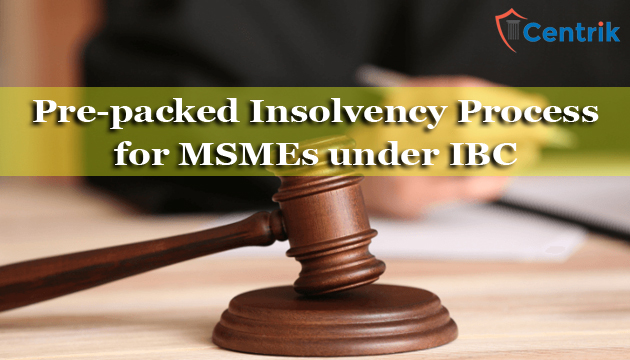
Status as on- 08/04/2022
Micro, Small and Medium Enterprises, also known as MSMEs have immensely contributed in the growth of Indian economy which includes the generation of employment as well. As on date, there are over 6 crore MSMEs registered in India which includes 5.7 crore registration done via Udyam Registration Portal. But, as soon as MSME industry started booming, the pandemic hit which caused a great disruption for businesses and even the large companies had a war chest to tide over these times.
To provide a relief to MSME and to offer them some respite from this pandemic, the process of pre-packaged insolvency resolution was introduced. This PIRP was introduced by way of ordinance dated 04.04.2021 by the Ministry of Law and Justice.
Applicability
The Ordinance mentioned that the application for PIRP can be made only in case if a corporate debtor qualifies as an MSME under Section 7(1) of the Micro, Small and Medium Enterprises Development Act, 2006.
It also provided the threshold amount for initiation of PIRP which is between Rs.10,00,000 to Rs.1,00,00,000. In case the default is of more than the prescribed amount, the MSME can initiate CIRP under the Insolvency and Bankruptcy Code, 2016.
Prerequisites
The Corporate Debtor of the MSME (hereby applicant) can initiate the proceedings of PIRP by submitting an application in the prescribed form with the affidavit, declarations, records and documents along with a fee of Rs.15,000 within 90 days of default, provided that:
- If the applicant is a company, then the approval of 75% of the shareholders is mandatory;
- If the applicant is a partnership firm, then the approval of ¾ of the partners is must;
- It must have obtained the approval of unrelated financial creditors representing 66% in value of the total financial debt due;
- The applicant must not be or has not undergone any CIRP/PIRP during a period of 3 year prior to the PIRP initiation;
- There must not be any order of liquidation passed against the applicant;
- The applicant must be eligible to submit a resolution plan under section 29A of the Code;
Key steps involved in PIRP
Step 1: If the application for PIRP is complete then it is admitted by NCLT within 14 days
Step 2: At this point, the PIRP is commenced and the moratorium is declared and RP is appointed by the NCLT.
Step 3: The MSME has to submit the base resolution plan to RP within 2 days along with the list of claim of creditors and other relevant documents.
Step 4: Formation of COC by RP
Step 5: Evaluation of base resolution plan by COC
Step 6: COC has 2 options, either it can approve base resolution plan only if it does not impair any claims of the MSME’s operational creditors or it does not approve the plan. If the COC does not approve such plan then the RP has to invite competing resolution plans from prospective resolution applicants.
Step 7: Then the competing plans are evaluated and selected.
Step 8: At this stage, the base plan is evaluated against selected competing plans:
-
- If selected competing plan is considered ‘significantly better’ than base resolution plan (based on scoring and criteria laid down by COC), selected plan to be put up for COC voting
- If selected competing plan not ‘significantly better’, submitters of base resolution plan and competing plans to be given an option to improve their plans. Highest scored plan amongst the improved plans to be put up for COC voting
- If no competing plans received, base resolution plan to be put up for COC voting
Step 9: The resolution plan is lastly approved by NCLT provided it is compliant with IBC and contains provisions for effective implementation.
Conclusion
PIRP is indeed a commendable step provided to MSME for speedy, flexible and collaborative process for resolution of financial stress. When the world was suffering, the base resolution plan acted as a relief for MSME as the process is undoubtedly speedier and more cost effective than any CIRP process.
Disclaimer: The above article is based on the personal interpretation of the related orders and laws. The readers are expected to take expert opinion before relying upon the article. For more information, please contact us at rera@centrik.in




 join For Updates
join For Updates